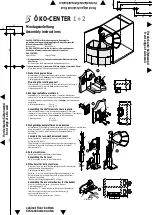
SECTION VII
7.0
CALIBRATION PROCEDURE:
7.0.1 The Oxygen Sensor and associated electronics have been accurately calibrated at factory.
The oxygen cell used, and the electronic circuits are extremely stable and in general
require calibration only when the 9-volt battery or the oxygen cell is replaced.
7.0.2 A simple way to perform push button calibration has been incorporated in the design
which permits the operator to quickly bring the system into calibration using the oxygen
content of normal air (20.9%) ±0.2% as standard.
7.1
METHOD OF CALIBRATION:
Calibration should be performed in a normal air environment and if possible, at room temperature
(68 to 78°F).
7.1.1 Turn power on by depressing the power “ON/OFF” push button. Wait approximately 10
seconds for display to stabilize. Display should read 20.9%
±
0.2. If proper reading is
obtained there is no need to calibrate. If an incorrect reading is obtained, look at the upper
left corner of the display. If “LO BAT” appears, indicating a low battery condition,
replace the 9-volt battery contained in the hub following the procedure given in Section
6.
Note:
When a 9-volt battery is replaced or temporarily removed, the memory circuits
within the hub may lose their charge and cause the display to produce an
abnormally low reading. If all the charge has leaked off, the reading will be zero.
7.1.2 To perform the simple push button calibration depress the “Display Light” push button
labeled “1” and while holding it in depress the power “ON/OFF” push button labeled “2”.
Now release both. The display will jump to a low-value and quickly climb to a correct
reading of 20.9%
±
0.2. The order of button depression must be followed in the order
described.
7.1.3 No further adjustment is required.
Note:
If the oxygen cell has reached end of life, calibration will not be possible. A lower
display reading of random value will be obtained each time calibration is
attempted. Cell replacement must be performed to re-establish normal usage. See
sell replacement in this manual.
16
















































